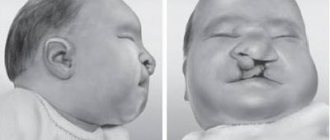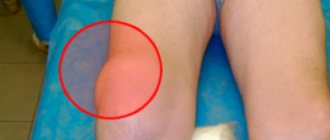Bronchiolitis is a dangerous disease that affects the human respiratory system. Bronchiolitis provokes inflammation in the bronchioles, blocking the passage through these organs. Bronchioles differ from bronchi in that they do not have cartilaginous plates and their size does not exceed 2 mm. Unfortunately, this disease most often occurs in newborns under one year of age. Cases of the disease in adults are quite rare. The most dangerous is acute bronchiolitis in a child under 2 years of age.
Bronchiolitis: treatment in adults
Treatment of bronchiolitis in adults depends on the underlying disease. Most often, bronchiolitis is diagnosed when irreversible changes in the lungs begin; the disease is difficult to treat and takes a long time. Acute bronchiolitis in adults is treated with bronchodilators, oxygen therapy, and corticosteroids. For isolated follicular bronchiolitis, corticosteroids, bronchodilators are used, and in some cases macrolides are prescribed. Improvement in respiratory bronchiolitis occurs after complete cessation of smoking.
Diagnostics
The diagnosis of bronchiolitis is established on the basis of complaints, examination (a characteristic box sound is heard during percussion, and wheezing fine bubble rales on exhalation during auscultation), X-ray examinations and computed tomography. In the case of severe bronchiolitis, the X-ray image clearly shows pathological changes in the structure of the lung, however, in some forms of bronchiolitis, the X-ray image is not informative; in these cases, computed tomography is used for diagnosis.
Bronchiolitis in adults: symptoms and treatment of bronchiolitis obliterans
Bronchiolitis obliterans is characterized by a concentric narrowing of most of the terminal bronchioles, the lumen of which is overgrown with connective tissue. Bronchiolectasis develops with an accumulation of macrophages, creating mucus plugs in the bronchioles. The idiopathic form of bronchiolitis obliterans is rare; in most cases, doctors can find the cause of the development of the pathological process. Conditions associated with bronchiolitis obliterans:
- Respiratory infections, adenoviruses, cytomegalovirus, parainfluenza virus, human immunodeficiency virus and other conditions.
- Complications after taking medications.
- Damage from toxic substances.
- Autoimmune diseases (diffuse connective tissue diseases).
- Complication after organ transplantation.
- Complication after radiation therapy.
- Various intestinal diseases.
- Hypersensitivity pneumonitis.
- Aspiration.
- Stevens-Johnson syndrome.
One of the main symptoms of bronchiolitis obliterans is progressive shortness of breath. At the initial stage of development of the disease, it bothers the patient during fast walking or physical activity; as the disease progresses, any movement or nervous tension causes severe shortness of breath, often accompanied by a cough. Bronchiolitis may be accompanied by the development of a pathological process in the large bronchi. Symptoms of bronchiolitis obliterans can be similar to the symptoms of viral bronchitis; the disease has an abrupt course - a serious condition is replaced by improvement, stable periods in the patient’s condition. Treatment of bronchiolitis obliterans is carried out depending on the underlying disease - this can be hormonal therapy, macrolide antibiotics, antifungal drugs, oxygen therapy.
Symptoms
The first signs of bronchiolitis are nonspecific. They resemble the symptoms of a common cold - persistent low-grade fever, patient anxiety, refusal to eat, runny nose, nasal congestion, weakness, headache. A few days later, a painful cough, shortness of breath on exhalation, and wheezing develop. The temperature can reach 39-40°C. This indicates the addition of a secondary bacterial infection. Often there is a sore and sore throat, lacrimation, swelling of the eyelids, injection of the sclera.
Signs of bronchiole obstruction are pathognomonic of the disease. These include:
- Rapid and shallow breathing,
- Shortness of breath at rest
- Excessive dry or fine wheezing, whistling-like
- Exhausting, hacking cough with a small amount of viscous sputum that is difficult to clear,
- Tachycardia,
- Stinging pain in the chest,
- Chest bloating
- Retraction of intercostal spaces,
- Acrocyanosis,
- Puffiness of the face,
- Sleep apnea
- Hepatosplenomegaly,
- Vomit,
- Thickening of the phalanges of the fingers.
Forced position of the patient - the chest is fixed in the inhalation position with the shoulder girdle raised.
Chronic bronchiolitis is characterized by an abrupt course, when periods of relative well-being are replaced by exacerbation of the disease. Despite the long-term remission, complete resolution of the pathology does not occur.
In children of the first years of life, the symptoms described above develop rapidly. Typically, the full clinical picture of bronchiolitis is formed within a couple of days. Children become weak, often capricious, sleep poorly, refuse to eat, do not play, and lie down a lot. Wheezing and noisy breathing can be heard from a distance. Due to the hyperairiness of the lung tissue, the intercostal spaces expand and protrude, shortness of breath occurs on exhalation, and the cough becomes painful and paroxysmal. Infants have a very difficult time with this disease. Clinical signs in children are very dynamic: they are characterized by rapid change.
Obliterating chronic bronchiolitis
Obliterating chronic bronchiolitis is a serious disease that develops as a consequence of acute bronchiolitis. The patient is constantly bothered by shortness of breath, a cough appears, the skin acquires a grayish or bluish tint, appetite may be disrupted, an increased heart rate, nausea may occur, vomiting may begin, the patient becomes irritable, and loses weight. Various risk factors contribute to the development of chronic bronchiolitis:
- Difficult ecology.
- Active and passive smoking.
- Harmful working conditions.
Damage to the bronchioles by the pathological process leads to disruption of the passage of oxygen through the bronchioles, a decrease in blood circulation and gas exchange in the lung tissues, resulting in the development of pulmonary emphysema, which is characterized by the destruction of the walls of the alveoli and the expansion of the bronchioles. Chronic obliterating bronchiolitis occurs in several types:
- Unilateral focal bronchiolitis.
- Bilateral focal bronchiolitis.
- Unilateral total bronchiolitis (McLeod syndrome).
- Bilateral lobar bronchiolitis.
- Unilateral lobar bronchiolitis.
The most common form of the disease is unilateral focal bronchiolitis. Unilateral bronchiolitis has a more favorable prognosis than the bilateral version. Bilateral bronchiolitis often leads to the development of cardiopulmonary failure. Diagnosis of the disease is carried out using pulmonary function tests, bronchoscopy, bronchography, and extended computed tomography of the chest organs. Additionally, studies of the state of the heart are prescribed - electrocardiography, Dopplerography, echocardiography. Treatment of chronic bronchiolitis obliterans is carried out using antibacterial, antiviral or antifungal therapy; mucolytics and vasodilators are prescribed to improve the removal of mucus from the respiratory tract. Patients are prescribed physiotherapeutic procedures and massages.
Etiology and pathogenesis
Bronchiolitis is a polyetiological disease. The most common cause of the disease is infection, predominantly viral. The causative agents of pathology in 80% of cases in infants and young children are adenoviruses, coronoviruses, respiratory syncytial virus, and enteroviruses. Preschoolers and schoolchildren suffer from bronchiolitis caused by mycoplasma, chlamydia, legionella, klebsiella, cytomegalovirus, and herpes virus.
In addition to infection, causes of bronchiolitis include:
- Autoimmune diseases - rheumatism, collagenosis, lupus, vasculitis,
- Tracheobronchitis, laryngitis, sinusitis,
- Complications of drug therapy - chemotherapy or antibiotic therapy,
- Inhalation of poisonous and toxic substances - gases, dust, nicotine, cocaine,
- Allergic alveolitis,
- Aspiration pneumonia,
- Inflammation of the gastrointestinal tract - ulcerative colitis, Crohn's disease,
- Malignant histiocytosis,
- Lymphoma.
There is also idiopathic bronchiolitis, which develops for no apparent reason.
The risk group for bronchiolitis includes:
- Children, especially 1-2 years of age,
- Persons with weakened immune systems,
- Patients after transplantation operations,
- Aged people,
- Experienced smokers
- People working in polluted and dusty air conditions.
Factors contributing to the development of bronchiole inflammation:
- Chronic respiratory diseases,
- Congenital anomalies of the lower respiratory tract,
- Hemodynamic disorders and cardiovascular disorders,
- Immunodeficiency,
- Low standard of living,
- Smoking during pregnancy and passive smoking,
- Pathology of the neuromuscular system,
- Hereditary predisposition.
The pathogenesis of bronchiolitis consists of the following sequential changes:
- Inflammatory infiltration and cellular proliferation of the bronchiole mucosa,
- Swelling of the mucous membrane,
- Narrowing of the bronchioles and thickening of their walls,
- Hyperproduction of mucus,
- Filling the lumen of bronchioles with mucous secretion,
- Violation of their patency,
- Thickening of mucus
- Destruction of the epithelial cover,
- Overgrowth of connective tissue
- Bronchoobstruction,
- Difficulty breathing
- Hyperairy lungs,
- Emphysematous changes
- Complete obstruction of bronchioles,
- Development of atelectasis,
- Changes in the normal structure of the distal parts of the bronchial tree,
- Impaired ventilation of the lungs,
- Lack of oxygen and excess carbon dioxide in the blood,
- Persistent respiratory dysfunction.
Clinical manifestations of acute bronchiolitis, with a favorable course, disappear on their own after three to four days. The disease is regressing. In this case, signs of obstruction may persist for another 2-3 weeks.
As the pathology progresses, irreversible changes occur in the bronchioles. They narrow concentrically, their lumen becomes clogged with scar tissue, bronchiectasis develops, secretions stagnate, and mucus plugs form. Decreased local blood flow increases pressure in the pulmonary artery system. Pulmonary hypertension increases the load on the heart, which leads to hypertrophy of the right ventricular myocardium.
The outcome of severe forms of pathology is:
- Replacement of lung parenchyma with non-functioning connective tissue,
- Development of progressive pulmonary dystrophy,
- Persistent dysfunction of the bronchi and lungs.
Follicular bronchiolitis
Follicular bronchiolitis is characterized by the presence of hypertrophied lymphoid follicles in the wall of bronchioles. Follicular bronchiolitis most often occurs in patients with immunodeficiency conditions, Sjogren's syndrome, mycoplasma infection, and viral diseases. Idiopathic follicular bronchiolitis is rare. Symptoms of the disease are high body temperature, progressive shortness of breath, cough, and sometimes recurrent pneumonia. X-rays may show diffuse nodular reticular or small nodular tissue changes, which may be associated with mediastinal lymphadenopathy. Enhanced computed tomography helps to identify centrilobular nodules located subpleurally and along the vessels; lymphoid infiltration of connective (interstitial) tissue in the lungs is detected.
You can undergo a full examination for bronchiolitis at the diagnostic center of the Yusupov Hospital. Various blood and urine tests are carried out in the clinical laboratory of the hospital. Patients are provided with a patient delivery service and comfortable 24-hour hospital rooms. Studies that are not carried out at the Yusupov Hospital can be completed in a network of partner clinics. Yusupov Hospital is a modern medical center providing services in various areas of medicine. You can make an appointment by calling the hospital.
Diagnostic measures
Diagnosis of bronchiolitis begins with examination and questioning of the patient. To correctly make a diagnosis, it is necessary to find out all previous diseases, study clinical manifestations, and conduct a physical examination. Auscultation reveals multiple fine-bubble wheezing, crepitus, and prolonged exhalation; during percussion - a sound with a boxy tint.
- X-ray of a child: typical bilateral perihilar bronchiolitis
X-ray of the lungs - hyperpneumatization, accumulation of fluid in the peribronchial tissue, proliferation of fibrous fibers in large bronchi, a clear image of blood vessels over the entire surface of the lungs, collapse of some parts of the lung and swelling of others, expansion and strengthening of the roots, limited mobility of the diaphragm.
- Computed tomography is a leading and very valuable method for diagnosing bronchiolitis, allowing one to determine the type of lesion, prevalence, degree of ventilation impairment and the dynamics of the process. Tomographic signs of pathology: narrowing of the bronchioles, their deformation, the presence of contents in the lumen, proliferation of granulation tissue inside the bronchioles, thickening of their outer membrane. Areas of lung tissue near the affected bronchioles lose their airiness, collapse and become organized.
- Additionally, pulse oximetry and determination of blood gas composition are performed. Patients show signs of bronchial obstruction, increased airiness of the lungs due to difficulty exhaling, a decrease in the amount of gases diffusing between the alveoli and pulmonary capillaries, a lack of oxygen in the blood and excess carbon dioxide.
- ECG and echocardiography are additional methods that detect signs of pulmonary hypertension.
- Spirometry can detect persistent bronchial obstruction.
- Pneumotachometry—impaired lung function.
- Laboratory diagnosis consists of performing an enzyme immunoassay or immunofluorescence reaction to detect the pathogen in a nasopharyngeal smear. PCR allows you to determine the genetic material of the microbe in the test sample.
Bronchiolitis is usually diagnosed in the later stages, when gross fibrotic changes have already formed in the bronchioles. In such cases, the prognosis is considered unfavorable. Early diagnosis and “aggressive” therapy make it possible to achieve regression of inflammation and relief of the disease.
Kinds
Considering the provoking factors, in medicine there is the following classification of bronchiolitis:
| Name | Description |
| Post-infectious | The inflammatory process in the area of small bronchi is provoked by infectious diseases. |
| Inhalation | Irritation of the respiratory tract occurs as a result of inhalation of toxic fumes, gases, dust, and cigarette smoke. |
| Medication | Pathological processes develop during treatment with certain medications or as a result of an allergic reaction. |
| Idiopathic | The causes of the disease cannot be determined. |
| Obliterative | Damage to the respiratory system occurs against the background of HIV infection and herpes. |
A pulmonologist will help you establish an accurate diagnosis. The specialist will prescribe a comprehensive examination, taking into account the patient’s complaints, and draw up a special treatment regimen individually for each patient.
Consequences and complications
As complications of untimely treatment, pneumonia may develop, and less commonly, cardiac or respiratory failure may develop.
As a rule, complications with bronchiolitis occur against the background of reduced immunity, as well as with improper treatment.
Additional chronic diseases that previously did not respond to adequate therapy can aggravate the course of the disease.
In adults, the prognosis is more favorable. With timely detection of the disease and treatment, bronchiolitis resolves within 2-2.5 weeks.
If the patient has a severe course of the disease and heart failure occurs, then as a result, death is possible.
Prevention
Pathological changes in the respiratory system can be prevented by simply remembering the simple recommendations of specialists:
- Maintain a healthy and active lifestyle. Strengthen your immune system, avoid hypothermia, exercise.
- It is important to eat right not only during the treatment of bronchiolitis, but also during the recovery stage, especially if there is a tendency to allergic reactions.
- Completely give up bad habits (alcohol, tobacco, drugs).
- Strengthen the immune system with vitamin complexes, especially during epidemics.
- If work involves interaction with harmful substances, it is necessary to use protective equipment.
- Avoid contact with sick people.
It is also necessary to promptly treat any diseases of the respiratory system under the supervision of a pulmonologist. Avoid using medications at home and do not prescribe them yourself.
Varieties
Classification is carried out according to the nature of the course and etiology of development. According to pathology, the disease in adults is divided into types:
- Acute bronchiolitis. It is characterized by rapidly developing symptoms. The state of health quickly deteriorates and intoxication appears.
- Chronic bronchiolitis. Characterized by the expression of signs. They are not felt, do not cause anxiety to the patient, but become manifest.
Classification of the disease according to the type of pathogen:
- Post-infectious. Pathology occurs as a result of penetration of RSV, adenoviruses, and parainfluenza viral infection into the body.
- Respiratory bronchiolitis. This type of disease affects smokers under 35 years of age with 15 years of smoking experience or more.
- Inhalation. It is formed after human inhalation of heavy gases (carbon dioxide, sulfur dioxide), acid fumes, organic and inorganic dust.
- Obliterating bronchiolitis. The occurrence of pathology is caused by the entry of herpes viruses, pneumocystis, and HIV infection. This form of inflammation is dangerous; without treatment, it can lead to serious complications. If primary signs appear, you should visit a doctor.
- Drug. It is caused by the consumption of medications, such as penicillamine, and drugs containing interferon, amiodarone, and bleomycin.
There is an idiopathic type of disease, the causes of which have not been established. It can be combined with other diseases (collagen pathologies, pulmonary fibrosis, ulcerative colitis, lymphoma) and not combined with other diseases (pneumonia, interstitial lung disease).
Clinical picture
Bronchiolitis is more often observed in children in the first year of life. The onset of the disease is usually acute; when the process spreads from the trachea, large, medium and small bronchi to the bronchioles - gradual. The general condition is serious, high temperature (38.5-40°), the child is lethargic, his consciousness is darkened. There is pallor and cyanosis of the skin, the face is puffy, and swelling of the wings of the nose may be observed. The cough is wet, breathing is frequent, noisy, shallow. The chest is swollen, and during inhalation, retraction of its pliable parts appears. Dyspnea of mixed type with predominance of inspiratory. With percussion over the lungs, a tympanic sound is detected in the anterior parts of the chest; focal dullness usually does not occur. During auscultation, increased respiratory sounds and scattered fine rales are heard; Bronchophony and bronchial breathing are absent. Tachycardia is noted, pulse filling and blood pressure are often reduced. A certain increase in pressure is possible in the initial period of the disease. The boundaries of the heart are difficult to determine due to pulmonary emphysema, the sounds are muffled, and sometimes a gentle systolic murmur is heard at the apex and at the 5th point. The abdomen is often swollen, the liver is enlarged.
In the blood, as a rule, there is a decrease in oxygen and an increase in carbon dioxide; Metabolic acidosis is usually observed. Less commonly, normal or even reduced carbon dioxide levels are detected, which, with elevated pH values, indicates respiratory alkalosis.
Stages and degrees
Bronchiolitis often occurs not only in adults, but also in children. The pathology is accompanied by obstruction of the respiratory tract, so the patient needs medical attention.
There are the following types of inflammatory process:
| Name | Description |
| Spicy | Pathological processes develop rapidly, but the clinical picture appears in rare cases. The patient needs emergency medical care, since the risk of dangerous consequences is high. |
| Chronic bronchiolitis | Clinical signs of the inflammatory process appear gradually. As pathological changes progress, symptoms will intensify. |
Bronchiolitis (treatment in adults is determined by a pulmonologist, taking into account the symptoms of the disease and the person’s condition) can be primary or secondary. In the first case, the pathology develops independently. Secondary bronchiolitis is a consequence of a certain disease, against the background of which the bronchi and lung tissues were affected.









